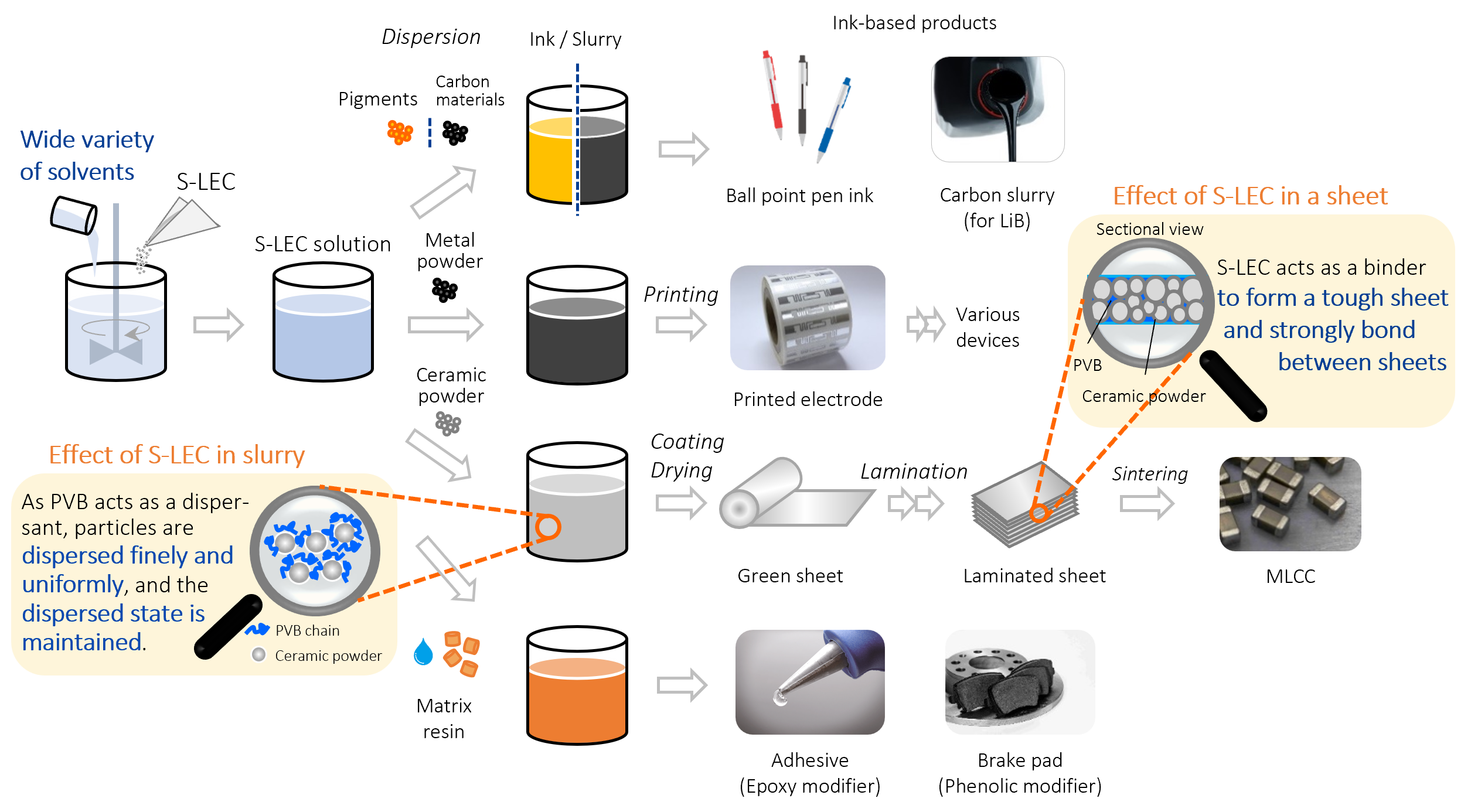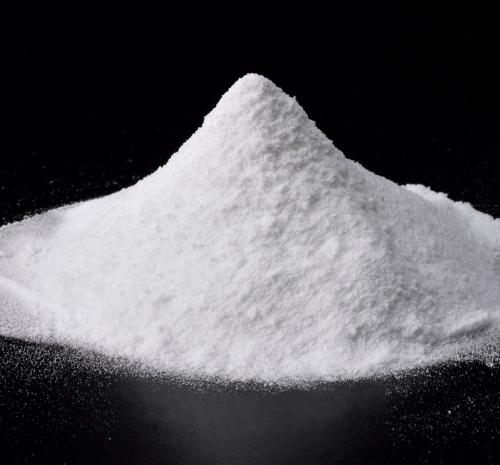Polyvinyl Acetal Resin S-LEC B / S-LEC K
Polyvinyl acetal resin (PVB) with excellent physical properties : Toughness, Adhesiveness and Dispersibility
● In addition to general polyvinyl butyral resin, various resins with different structure
and ratio of the acetal group is available.
● By adjusting the ratio of each group and degree of polymerization, it is possible to control
the material properties for various applications.
● Can be used in a wide range of applications such as binders, dispersants and adhesives.
Features
Polyvinyl acetal resin (PVB) exhibits various functions such as toughness, adhesiveness and dispersibility in a balanced manner, and contributes to satisfying the required quality for various applications.
Toughness

Adhesiveness

Dispersibility

Pyrolytic Property
 High Temp. Oven Green sheet
High Temp. Oven Green sheet
Solubility/Compatibility
 PVB powder
PVB powder
compatible with many solvents and resins.
Transparency
 Glass PVB
Glass PVBlayer
- ・Thickening property

- ・Moldability

- ・Insulation

etc …
Applications
PVB is used in a wide range of applications, including binders for MLCC and other ceramics, binders for conductive pastes, dispersants for pigments and carbon materials, modifiers for epoxy and phenolic resins, inkjet receptive layers, and adhesives and so on.
 MLCC
MLCC Other ceramic parts
Other ceramic parts Conductive paste
Conductive paste Paints / Inks
Paints / Inks Resin modifier
Resin modifierHow to Use S-LEC and Its Effects
By dissolving in a solvent suitable for each application and mixing with other materials, the adhesive properties and dispersibility characteristic of S-LEC can be demonstrated in products and their manufacturing processes.

Chemical Structure
The chemical and physical properties of S-LEC can be controlled by adjusting the molecular weight and the ratio of the three units composing PVB: acetal group, acetyl group and hydroxyl group. This allows us to propose suitable grades with properties that meet your needs.

- ※R= C3H8 : Polyvinyl Butyral
- R= CH3 : Polyvinyl Acetacetal
The above two are collectively called “polyvinyl acetal resin”.
◆ Control of material properties


※We also have a lineup of water-based PVB (S-LEC K KW/KX) with a high hydroxyl ratio.
Specifications
■Product grades
| Grade | Type | Calculated molecular weight ×104 |
Viscosity | Polymer composition | Tg | Volatiles | |||||||
|---|---|---|---|---|---|---|---|---|---|---|---|---|---|
| 5wt% | 10wt% | Hydroxyl content |
Acetyl content |
Acetal content |
|||||||||
| mPa・s | mol% | wt% | mol% | wt% | mol% | wt% | ℃ | % | |||||
| Low molecular- weight |
BL-10 | P | 1.6 | ー | 9 to 15 | c.a.25 | c.a.17 | 4 max | 5 max | c.a.73 | c.a.80 | 67 | 3 max |
| BL-1 | P | 1.9 | ー | 10 to 30 | c.a.33 | c.a.23 | 4 max | 5 max | c.a.66 | c.a.75 | 70 | 3 max | |
| BL-1H | P | 2.0 | ー | 10 to 30 | c.a.27 | c.a.19 | 4 max | 5 max | c.a.72 | c.a.80 | 68 | 3 max | |
| BL-S | P | 2.4 | ー | 10 to 30 | c.a.19 | c.a.13 | 6 max | 7 max | c.a.76 | c.a.81 | 66 | 3 max | |
| BL-2H | P | 2.8 | ー | 25 to 55 | c.a.27 | c.a.19 | 4 max | 5 max | c.a.72 | c.a.80 | 70 | 3 max | |
| BL-5Z | Z | 3.2 | ー | 30 to 50 | c.a.19 | c.a.13 | 4 max | 5 max | c.a.79 | c.a.85 | 67 | 3 max | |
| BL-7Z | Z | 3.9 | ー | 50 to 90 | c.a.28 | c.a.19 | 4 max | 5 max | c.a.71 | c.a.79 | 71 | 3 max | |
| Medium molecular- weight |
BM-1 | P | 4.1 | ー | 60 to 100 | c.a.31 | c.a.22 | 4 max | 5 max | c.a.68 | c.a.77 | 72 | 3 max |
| BM-5 | P | 5.3 | ー | 140 to 220 | c.a.31 | c.a.22 | 4 max | 5 max | c.a.68 | c.a.77 | 73 | 3 max | |
| BM-2(Z) | P/Z | 5.3 | ー | 100 to 170 | c.a.28 | c.a.19 | 4 max | 5 max | c.a.71 | c.a.79 | 71 | 3 max | |
| BM-S(Z) | P/Z | 5.3 | ー | 80 to 150 | c.a.19 | c.a.13 | 6 max | 7 max | c.a.76 | c.a.81 | 67 | 3 max | |
| BM-SHZ | Z | 5.3 | ー | 110 to 190 | c.a.19 | c.a.13 | 4 max | 5 max | c.a.79 | c.a.85 | 68 | 3 max | |
| High molecular- weight |
BH-S | P | 6.7 | 20 to 40 | ー | c.a.19 | c.a.13 | 6 max | 7 max | c.a.76 | c.a.81 | 67 | 3 max |
| BH-6 | P | 9.3 | 40 to 90 | ー | c.a.28 | c.a.19 | 4 max | 5 max | c.a.71 | c.a.79 | 73 | 3 max | |
| BH-3(Z) | P/Z | 10.8 | 60 to 120 | ー | c.a.31 | c.a.22 | 4 max | 5 max | c.a.68 | c.a.77 | 74 | 3 max | |
| BH-A | P | 11.6 | 35 to 65 | ー | c.a.20 | c.a.13 | 1 max3 | 7 max | c.a.67 | c.a.70 | 65 | 3 max | |
| Heat-resistant type |
BX-L | P | 1.8 | ー | 10 to 30 | c.a.33 | c.a.25 | 4 max | 5 max | c.a.66 | c.a.74 | 95 | 3 max |
| BX-1 | P | 9.8 | 70 to 140 | ー | c.a.31 | c.a.24 | 4 max | 5 max | c.a.68 | c.a.75 | 95 | 3 max | |
| BX-5(Z) | P/Z | 13.7 | 130 to 200 | ー | c.a.29 | c.a.22 | 4 max | 5 max | c.a.70 | c.a.77 | 92 | 3 max | |
| High heat- resistant type |
KS-10 | P | 1.8 | ー | 10 to 30 | c.a.16 | c.a.13 | 4 max | 5 max | c.a.83 | c.a.86 | 105 | 3 max |
| KS-1 | P | 3.2 | ー | 65 to 95 | c.a.16 | c.a.13 | 4 max | 5 max | c.a.83 | c.a.86 | 107 | 3 max | |
| KS-6Z | Z | 11.1 | 110 to 170 | ー | c.a.15 | c.a.12 | 4 max | 5 max | c.a.84 | c.a.87 | 113 | 3 max | |
| KS-5Z | Z | 13.4 | 210 to 270 | ー | c.a.15 | c.a.12 | 4 max | 5 max | c.a.84 | c.a.87 | 113 | 3 max | |
- Note
- Type : P = Powder, Z= Granule
- Viscosity : Ethanol / Toluene = 1/1 solution ( B-type viscometer / 20ºC)
- ※The above values are reference values, not guaranteed values.
■Solubility
| Grade | BL-1 | BL-2H | BL-5Z | BL-10 | BM-1 | BM-2 | BM-S | BH-3 | BH-A | BX-L | BX-5 | KS-6Z | KS-10 | |
|---|---|---|---|---|---|---|---|---|---|---|---|---|---|---|
| Alcohol | Methanol | S | S | I | S | S | S | I | S | S | S | S | S | S |
| Ethanol | S | S | S | S | S | S | S | S | S | S | S | I | S | |
| 1-Propanol | S | S | S | S | S | S | S | S | S | S | S | S | S | |
| 2-Propanol | S | S | S | S | S | S | S | PS | S | S | I | I | I | |
| 1-Butanol | S | S | S | S | S | S | S | S | S | S | S | S | S | |
| 1-Octanol | S | S | S | S | S | S | S | PS | S | S | S | I | S | |
| Ethylene glycol | I | I | I | I | I | I | I | I | I | I | I | I | I | |
| Ketone | Acetone | S | S | S | S | I | S | S | I | S | S | PS | S | S |
| Methyl ethyl ketone | S | S | S | S | S | S | S | PS | S | S | S | S | S | |
| Methyl Isobutyl ketone | I | I | S | S | I | I | S | I | S | I | I | I | I | |
| Cyclohexanone | S | S | S | S | S | S | S | PS | S | S | S | S | S | |
| Amide | Dimethylacetamide | S | S | S | S | S | S | S | S | S | S | S | S | S |
| NN,N-Dimethylformamide | S | S | S | S | S | S | S | S | S | S | S | S | S | |
| N- Methylpyrrolidone | S | S | S | S | S | S | S | S | S | S | S | S | S | |
| Ester | Methyl acetate | I | S | S | S | I | S | S | I | S | S | S | S | S |
| Ethyl acetate | I | S | S | S | I | S | S | I | S | PS | S | S | S | |
| n-Butyl acetate | I | I | S | S | I | I | S | I | S | PS | PS | PS | S | |
| 1,3-Butylene glycol diacetate | I | I | S | S | I | I | S | I | PS | I | PS | PS | S | |
| Ether | 1,4-Dioxane | S | S | S | S | S | S | S | PS | S | S | S | S | S |
| Tetrahydrofuran | S | S | S | S | S | S | S | S | S | S | S | S | S | |
| Hydrocarbon | Toluene | I | I | S | S | I | I | S | I | I | I | I | I | I |
| Xylene | I | I | S | I | I | I | I | I | I | I | I | I | I | |
| Hexane | I | I | I | I | I | I | I | I | I | I | I | I | I | |
| Others | Ethylcellosolve | S | S | S | S | S | S | S | S | S | S | S | S | S |
| Dimethyl sulfoxide | S | S | PS | S | S | S | PS | S | S | S | S | S | S | |
| Acetic acid | S | S | S | S | S | S | S | S | S | S | S | S | S | |
| Terpineol | S | S | S | S | S | S | S | PS | S | PS | S | I | S | |
| Butyl carbitol | S | S | S | S | S | S | S | PS | S | S | S | S | S | |
| Butyl carbitol acetate | I | PS | S | S | I | I | S | I | PS | I | PS | PS | S |
- ※Resin concentration : 5 wt%
- ※Solubility: S (Soluble), PS (Partially Soluble), I (Insoluble)
※Please refer to the catalog for other material properties.
S-LEC has other excellent features and is used in many applications.
For more information, please visit the product details page below.
Document download
認定証ダウンロードファイル一覧


 Mobility
Mobility